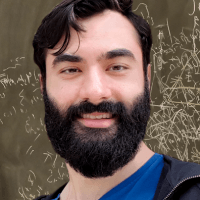
Sahand Hormoz
Harvard Medical School, Department of Systems Biology
Warren Alpert Building, Room 536
200 Longwood Ave.
Boston, MA 02115
Email: sahand_hormoz@hms.harvard.edu
Website: hormoz.dfci.harvard.edu
Summary
During development, for tissue maintenance, and in diseases, as cells proliferate, they transition between functionally and molecularly distinct states. Dysregulation of transitions between cell states can lead to pathologies such as cancer. In many biological systems, we would like to know which transitions can occur, in what sequence, and at what rates. Current single-cell methods have expanded our ability to identify distinct cell states but not our ability to directly measure their dynamics. For example, state of the art single-cell techniques can measure the expression levels of thousands of genes, but they destroy the cells in the process, and provide only static snapshots.
In our lab, we combine experiments and theory to understand the complex dynamics of cell state transitions in development and in disease. To do so, we expand and combine emerging experimental techniques. For example, we use time-lapse microscopy to track the lineage history of individual cells as they divide, followed by single-molecule imaging to readout the expression levels of multiple genes in the same cells. We also use synthetic biology to engineer novel genetic circuits that can retain the history of major transitions in each cell. One of our favorite model systems is mouse embryonic stem (ES) cells in culture, which can rehash slices of development on a dish, providing us with a rich playground.
At the same time, we also develop new theoretical frameworks to decipher the data generated in our experiments: for example, methods for inferring dynamics from single-cell lineage trees with endpoint gene expression measurements. Often inspired by concepts in statistical physics, we have used ideas from geometry, critical phenomena, and at times number theory. Ultimately, we seek to find general theoretical principles to understand the stochastic processes and collective dynamics that emerge in populations of proliferating cells.
Publications
DV Egeren, J Escabi, M Nguyen, S Liu, CR Reilly, S Patel, B Kamaz, M Kalyva, DJ DeAngelo, Ilene Galinsky, Martha Wadleigh, ES Winer, MR Luskin, RM Stone, JS Garcia, GS Hobbs, FD Camargo, F Michor, A Mullally, I Cortes-Ciriano, S Hormoz. Reconstructing the lineage histories and differentiation trajectories of individual cancer cells in JAK2-mutant myeloproliferative neoplasms. Cell Stem Cell 28 (3):514-523 (2021).
S Bowling, D Sritharan, FG Osorio, M Nguyen, P Cheung, A Rodriguez-Fraticelli, S Patel, WC Yuan, Y Fujiwara, BE Li, SH Orkin, S Hormoz*, FD Camargo*. An engineered CRISPR/Cas9 mouse line for simultaneous readout of lineage histories and gene expression profiles in single cells. Cell 181 (6):1410-1422 (2020). *co-corresponding authors. PMCID: PMC7529102.
C Budjan, S Liu, A Ranga, S Gayen, O Pourquie, S Hormoz. Paraxial mesoderm organoids model development of human somites. eLife 11:e68925 (2022). DOI: 10.7554/eLife.68925.
D Sritharan, S Wang, S Hormoz. Computing the Riemannian curvature of image patch and single-cell RNA sequencing data manifolds using extrinsic differential geometry. PNAS 118 (29) e2100473118 (2021). PMCID: PMC8307776.
KL Frieda*, JM Linton*, S Hormoz*, J Choi, KK Chow, ZS Singer, MW Budde, MB Elowitz, L Cai. Synthetic recording and in situ readout of lineage information in single cells. Nature 541 (7635): 107-111 (2017). *equal contribution. PMCID: PMC6487260.
